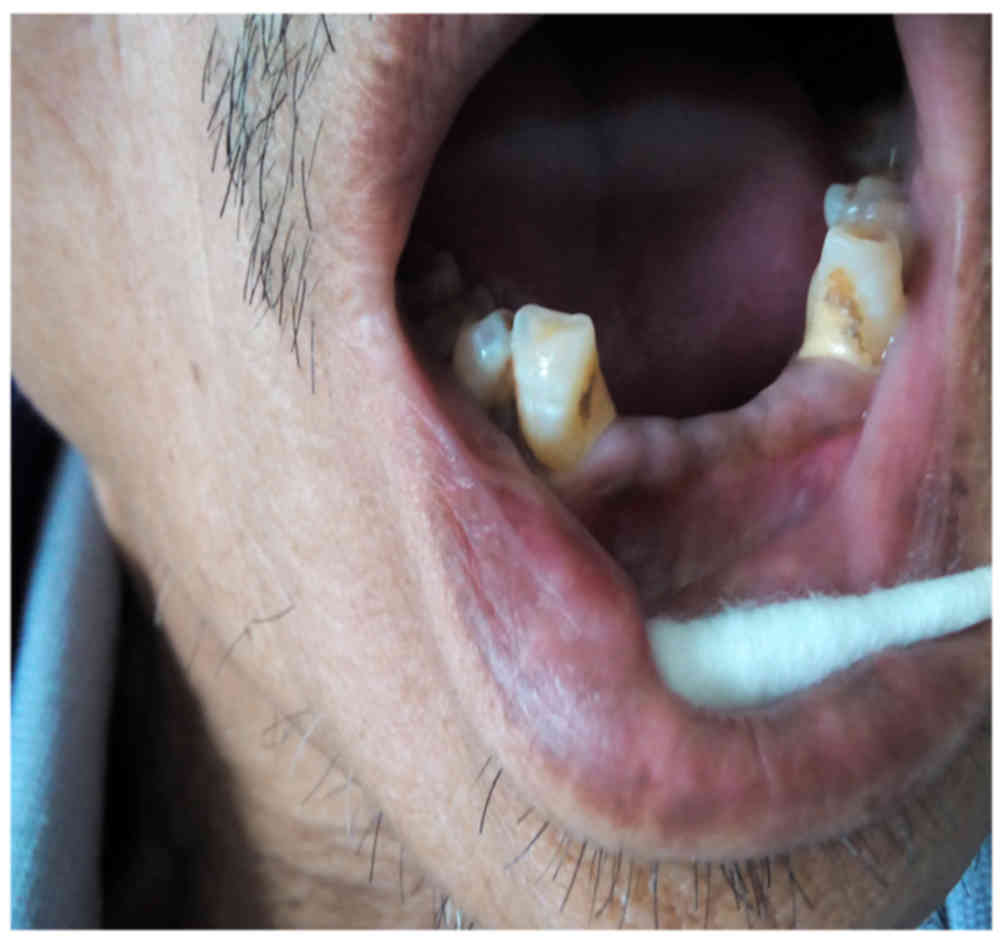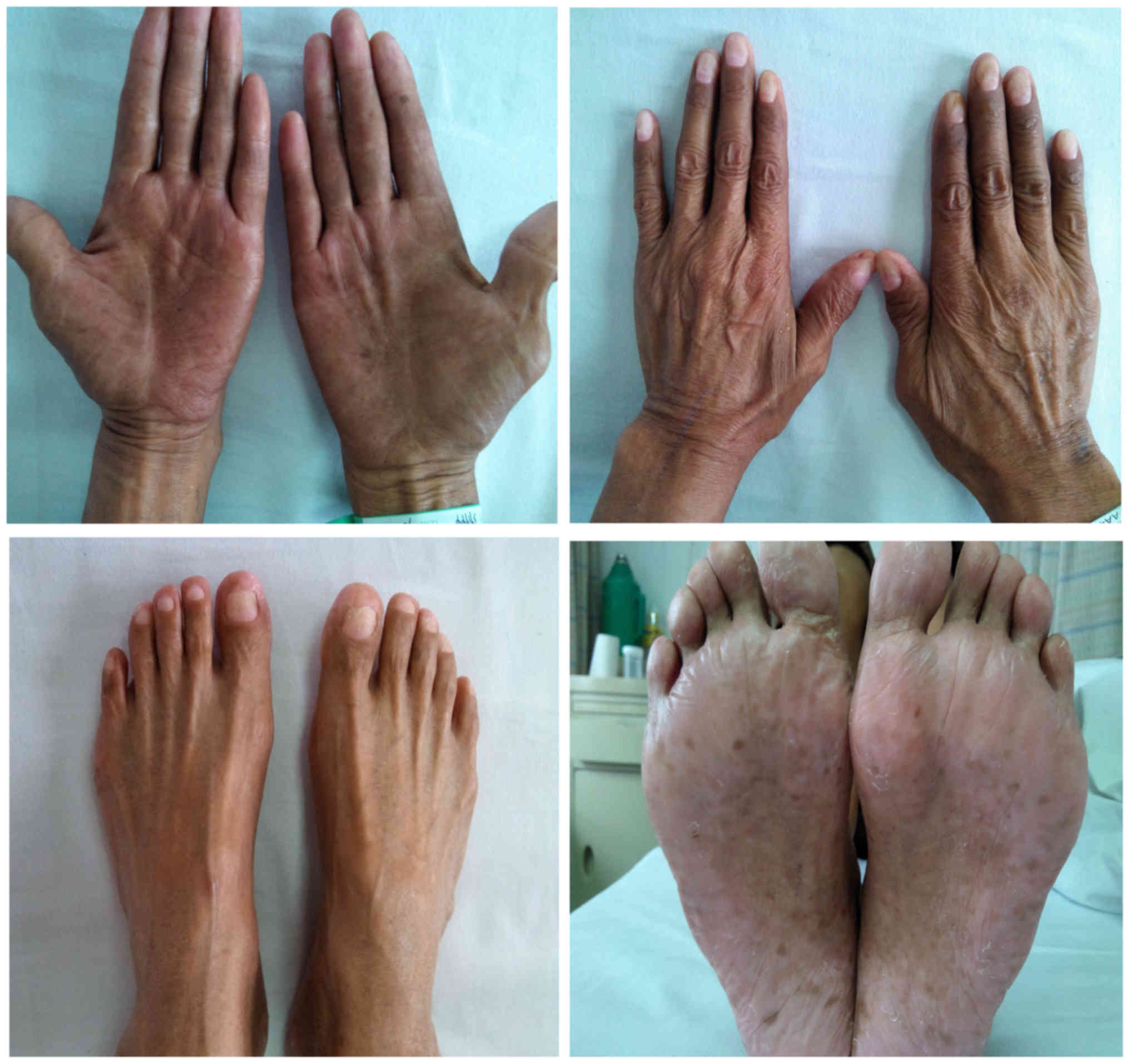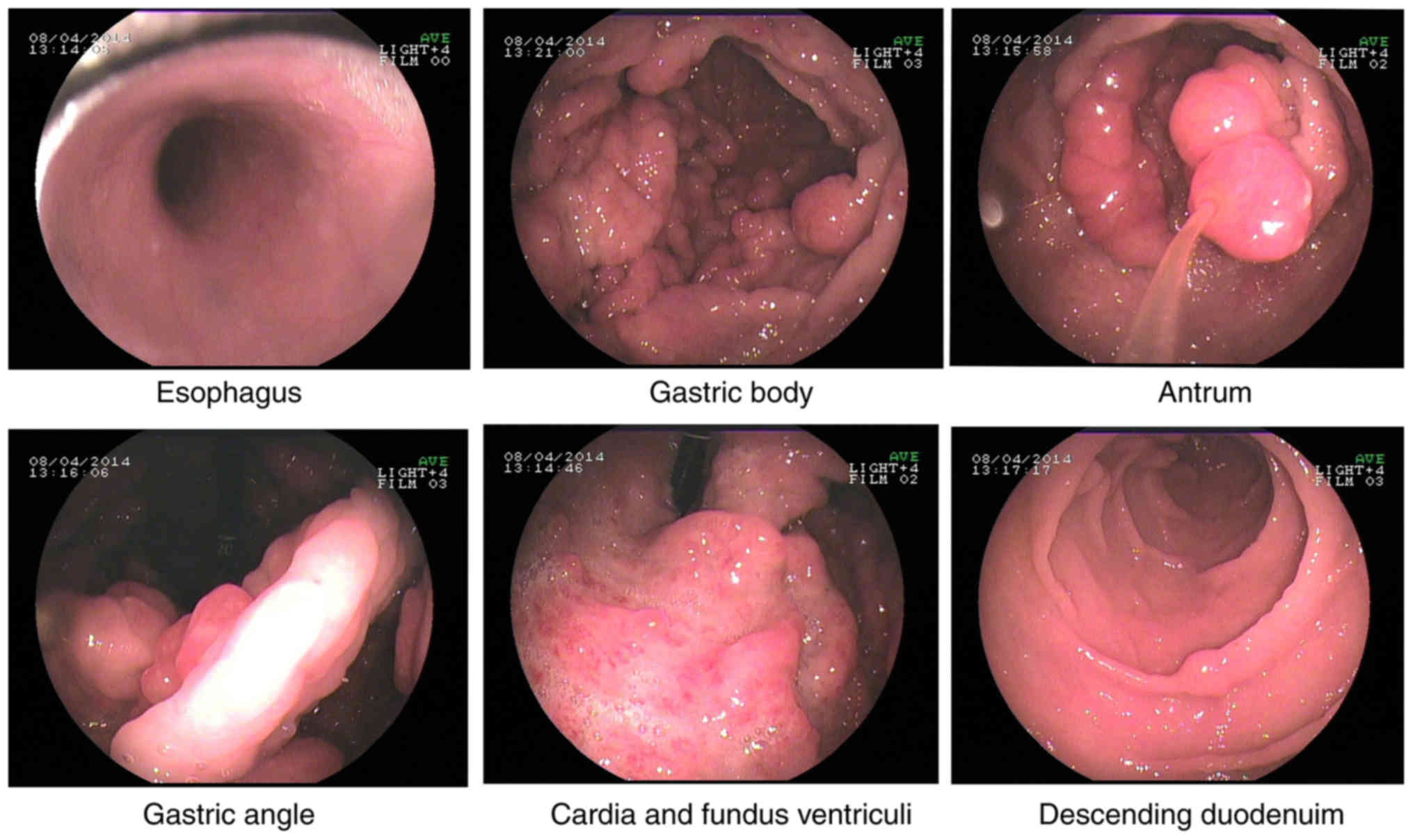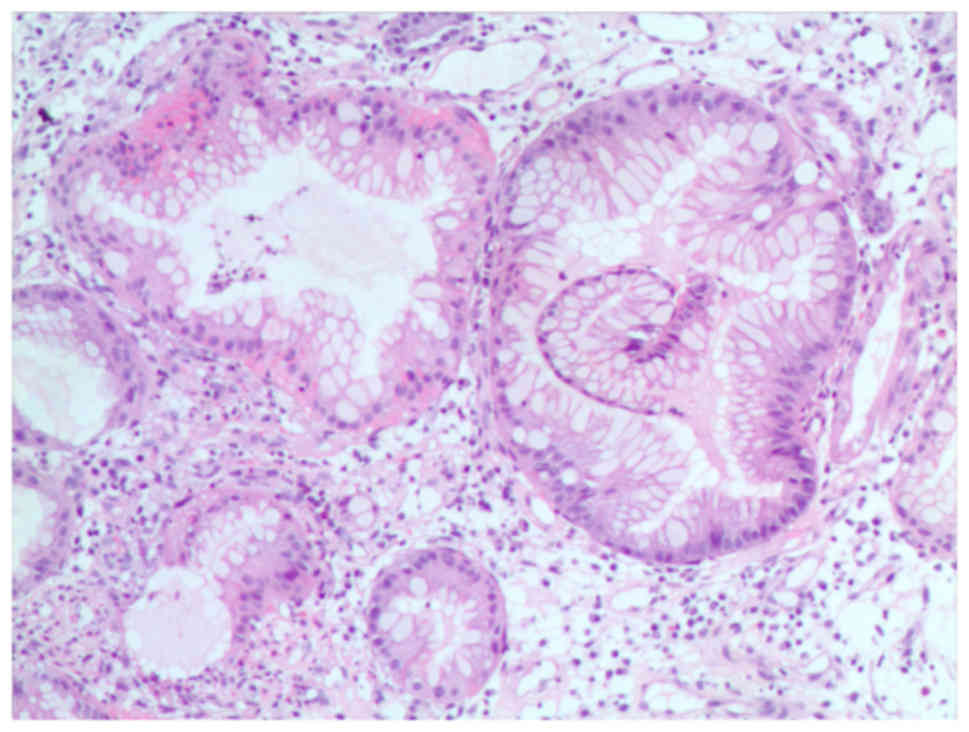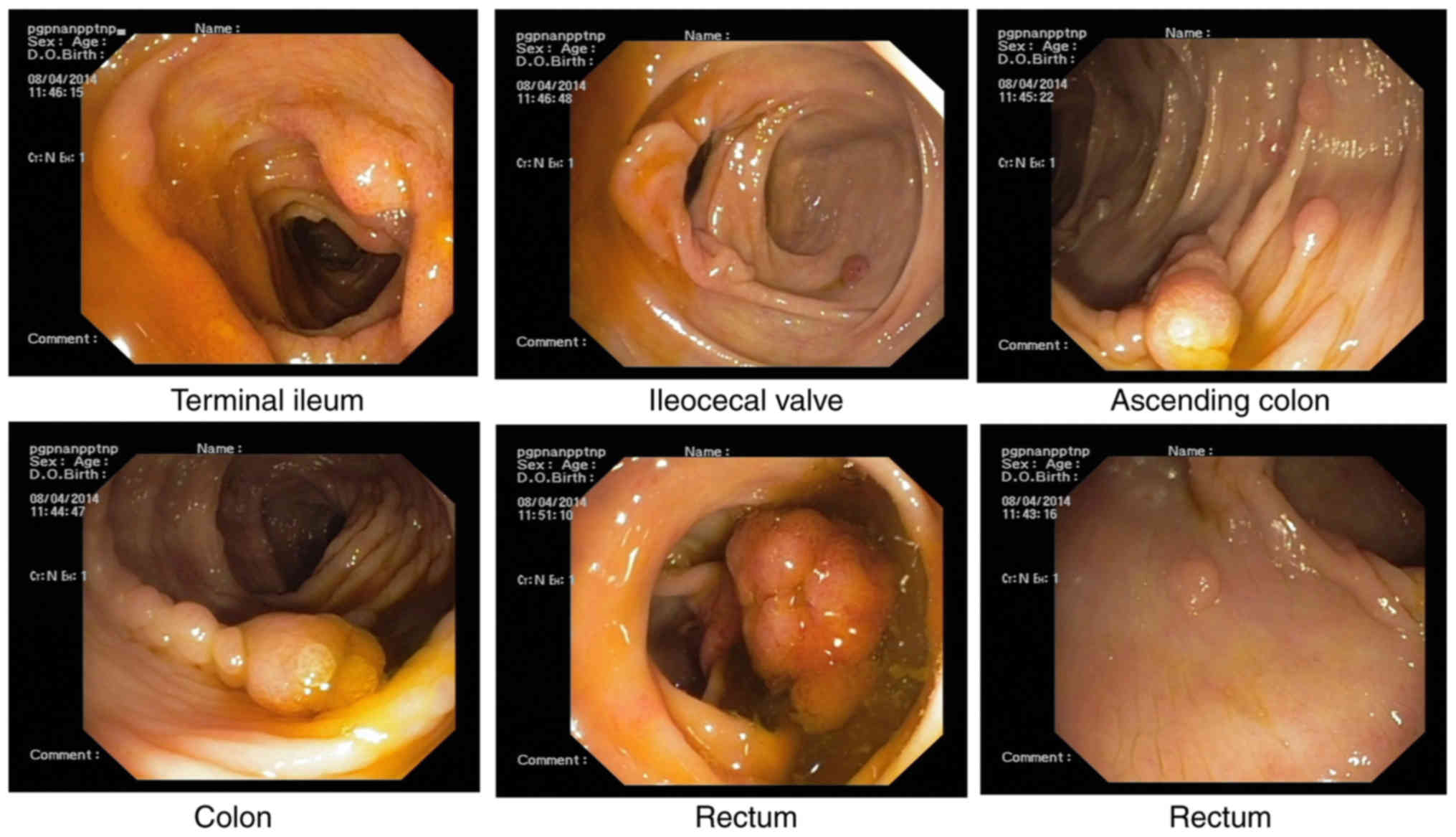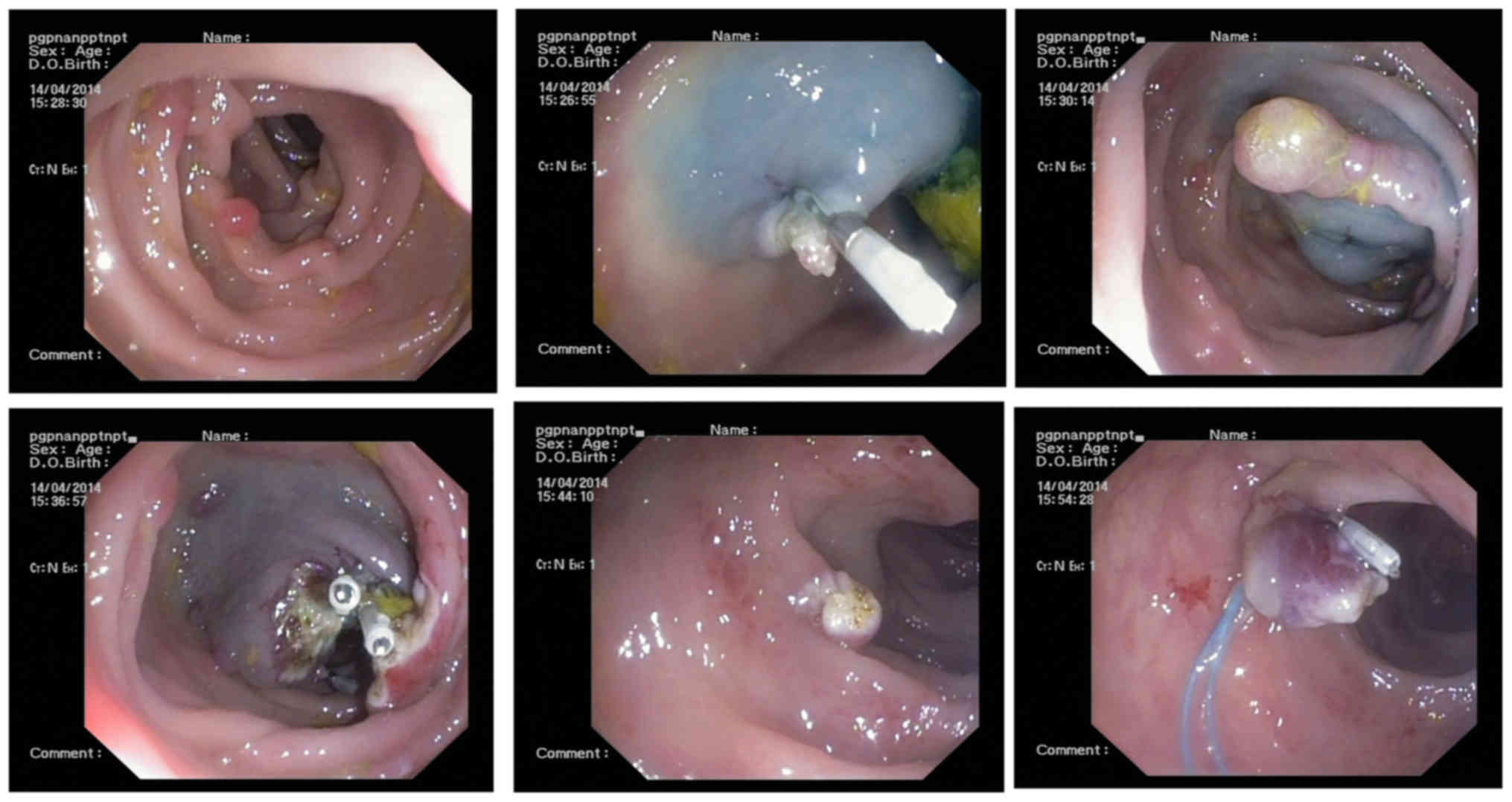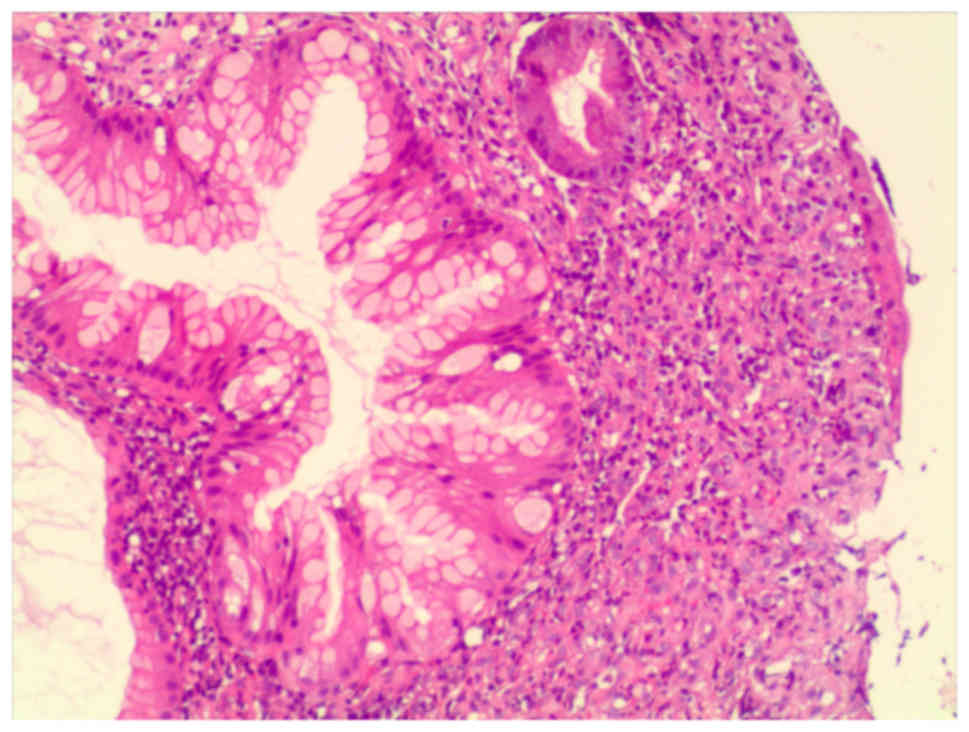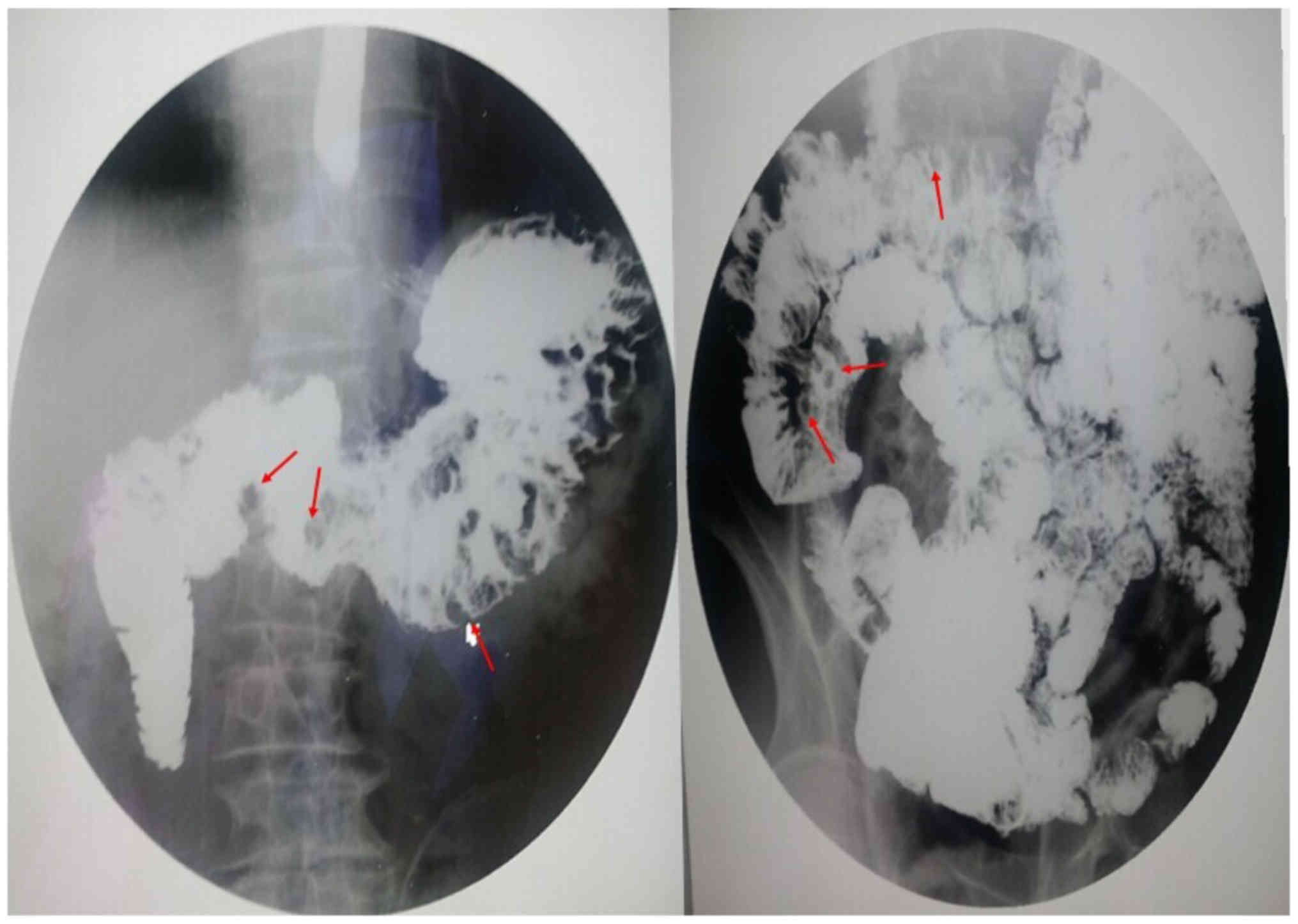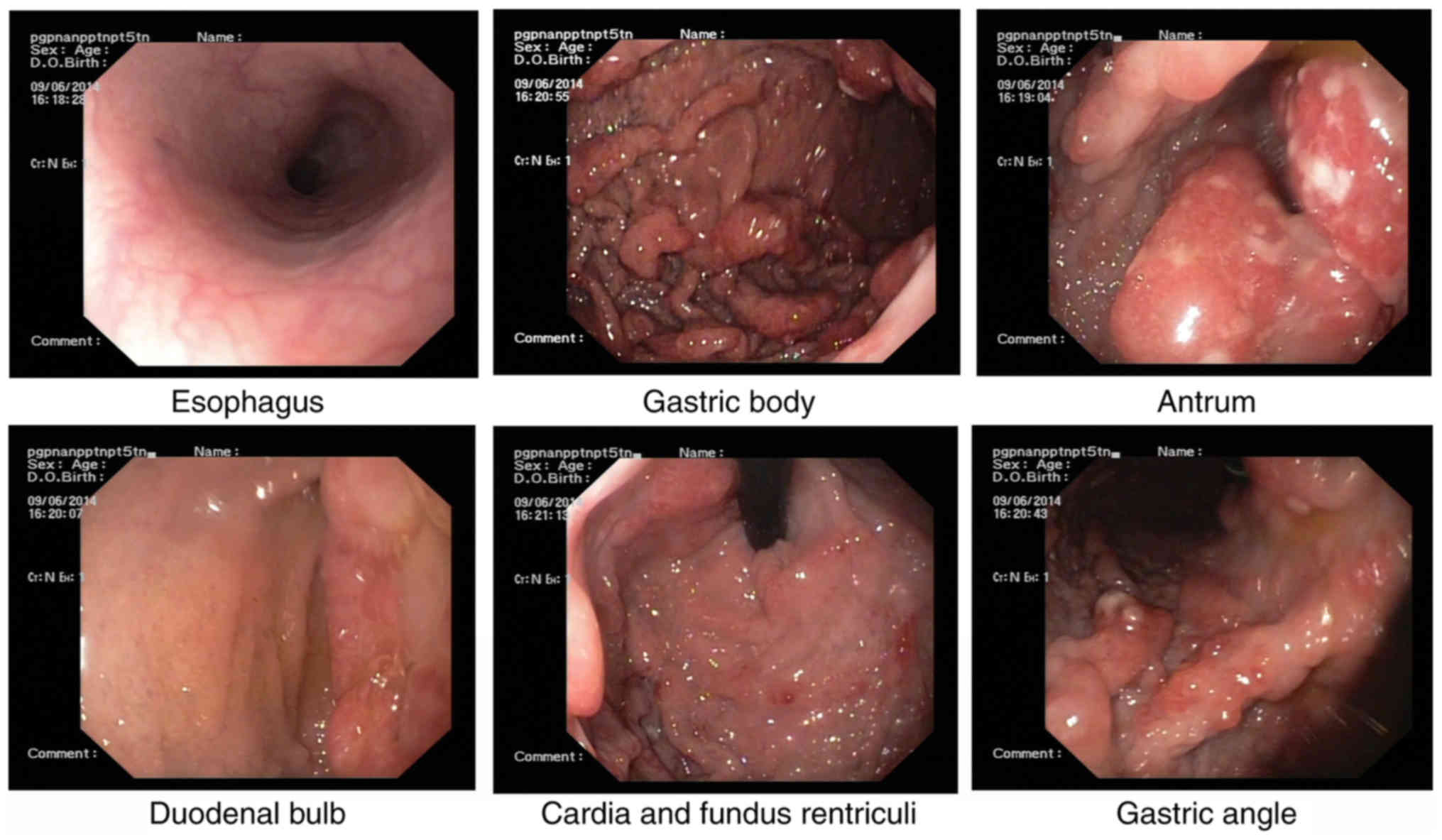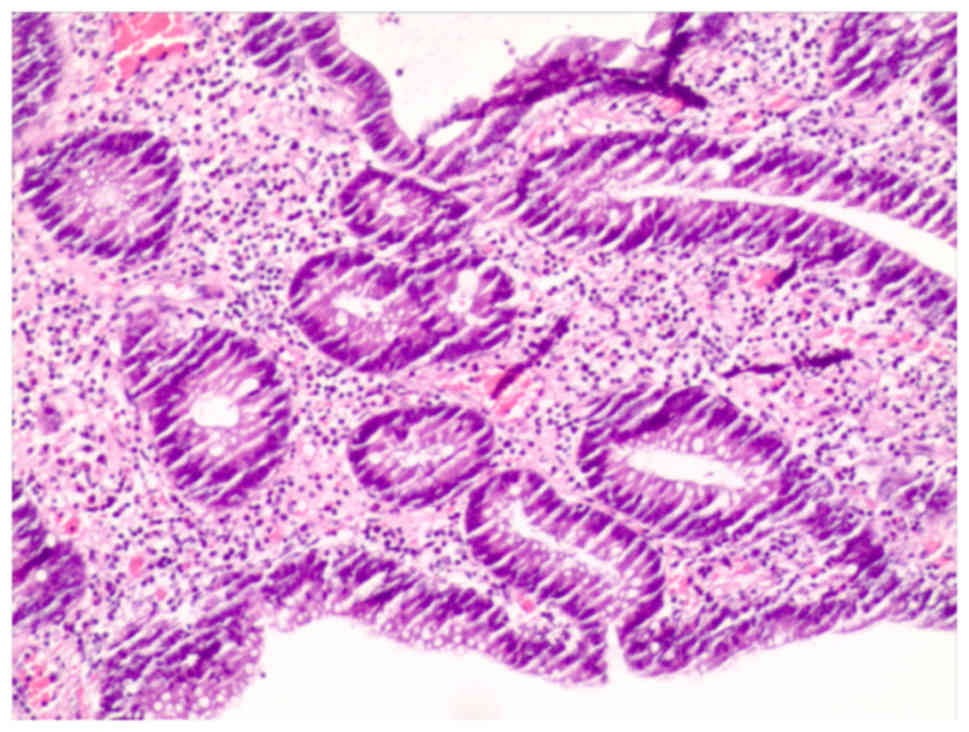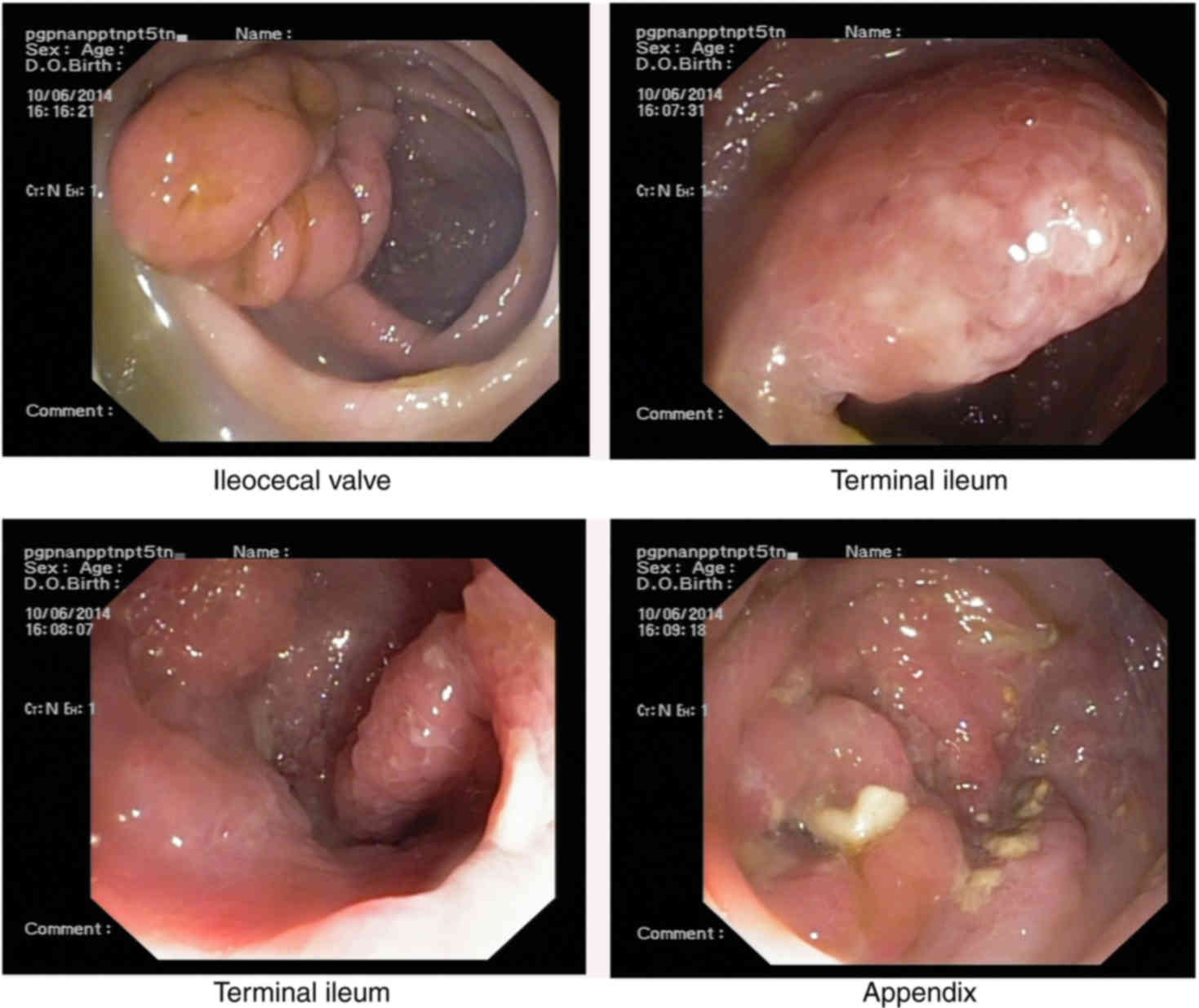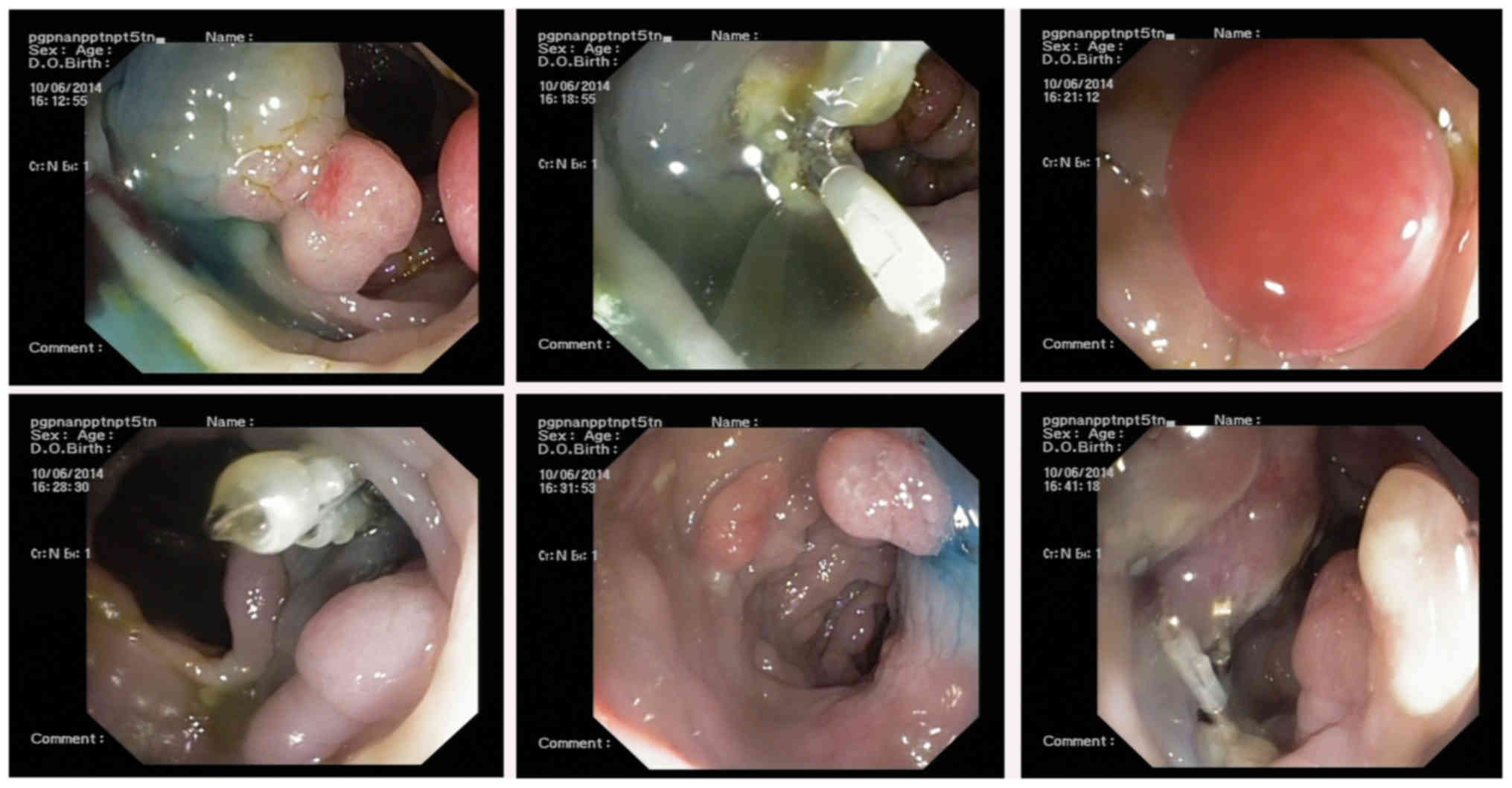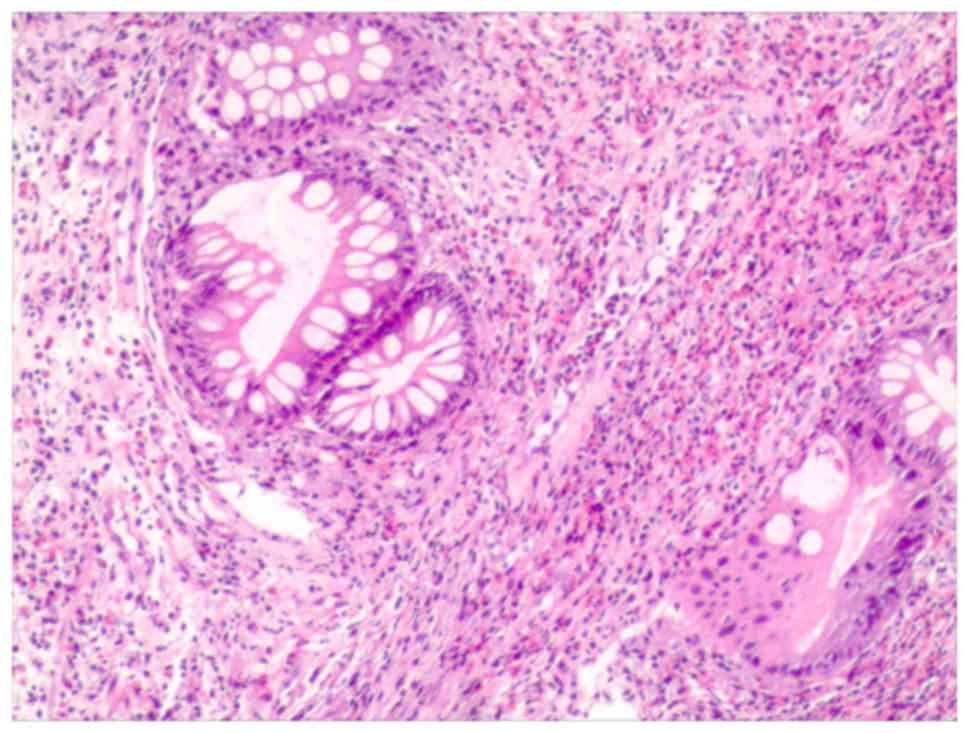Cronkhite‑Canada syndrome: A case report
- Authors:
- Published online on: April 2, 2018 https://doi.org/10.3892/ol.2018.8409
- Pages: 8447-8453
-
Copyright: © Yuan et al. This is an open access article distributed under the terms of Creative Commons Attribution License.
Abstract
Introduction
Cronkhite-Canada syndrome (CCS), also known as polyposis pigmentation-alopecia-onycholrophia syndrome, is a syndrome distinguished by gastrointestinal (GI) polyposis and ectodermal changes (1). It has been demonstrated that the incidence of CCS is 1 in a million (2). CCS affects more men compared with women, with a ratio of 3:2, and commonly occurs in the fifth decade of life, with a mean age of onset between 50–60 years (3). Cronkhite and Canada first described CCS in 1955, and CCS is a rare disease of unknown etiology (4). Following its identification, >500 cases have been described in the literature (5). Although the incidence of CCS is low, it is associated with a high mortality; 5-year mortality may be as high as 55% (6). At present, the treatments for CSS include corticosteroids, nonsteroidal anti-inflammatory drugs, proton pump inhibitors, H2-receptor antagonists, hyperalimentation, cromolyn sodium, antibiotics, anabolic steroids, surgery, 5-aminosalicylate acid, antitumor necrosis factor α agents and the eradication of Helicobacter pylori, or a combination of these therapies (7).
In the present case study, a 58-years-old male with CCS diagnosed at the Department of Gastroenterology, The Third Xiangya Hospital of Central South University (Hunan, China) is reported. The patient experienced a history of diarrhea and hematochezia for 4 months, with abdominal pain for 1 month and additional nail and toenail loss for half a month. The clinical, endoscopic and histological data confirmed the diagnosis. The patient was treated with proton pump inhibitors, gastric mucosal protective agents, endoscopic electrocision of colon polyps, glutamine capsule, nutrition support and Bifid triple viable capsules. The patient eventually recovered.
Case report
A 58-year-old male visited The Third Xiangya Hospital of Central South University (Hunan, Changsha, China) on June 6, 2014, with the primary complaint of diarrhea and hematochezia for 4 months, abdominal pain for 1 month and nail and toenail loss for half a month. Informed written consent was obtained from the patient for publication of the present study. The patient additionally felt tiredness and had experienced a weight loss of 5 kg in half a month. There were no abnormalities, including GI polyposis or colorectal cancer, in the family history of the individual. However, the patient had a history of alcoholic cirrhosis for >10 years, and 13 years prior to visiting The Third Xiangya Hospital of Central South University he had suffered from gastrorrhagia. The patient had been drinking 400 ml rice wine and smoking 20 cigarettes/day for 40 years.
Physical examination revealed that the patient was suffering from malnutrition, he was emaciated and had an anemic appearance, with a dermatological triad of hyperpigmentation in his oral mucosa (Fig. 1) and a brown pigmentation in his palms and feet (Fig. 2). Atrophy of fingernail and toenails were later observed, in addition to eventual toenail and nail loss.
Laboratory tests revealed that the patient's white blood cell count was 7.5×109/l (normal range, 4–10×109/l), platelet count was 216×109/l (normal range, 100–300×109/l), hemoglobin was 61 g/l, fecal occult blood test (+), C-reactive protein and erythrocyte sedimentation rate were normal, serum albumin was 28.5 g/l (normal range, 40–60 g/l) and serum total protein was 46.1 g/l (normal range, 60–80 g/l).
Esophagogastroduodenoscopy, performed for the further evaluation of the GI tract, revealed multiple nodules and granular polyps in the stomach and duodenum (Fig. 3).
In the present study, biopsy specimens were fixed in 4% paraformaldehyde at room temperature, dehydrated (75% ethanol for 45 min, 85% ethanol for 45 min, 95% ethanol for 45 min, 100% ethanol for 45 min, immersed in 100% isobutanol overnight and lastly transferred to 100% butanol for 3 h) and embedded in paraffin. Paraffin-embedded sections measuring 4 µm-thick were then stained with 0.5% hematoxylin for 2 min and 1% eosin for 1 min at room temperature (H&E). Finally, the sections were observed under a light microscope (magnification, ×100; Olympus BX51; Olympus Corporation, Tokyo, Japan,).
Biopsy specimens from the gastric antrum mucosa displayed mucosal chronic inflammation, edematous stroma with inflammatory cell infiltration, small blood vessel proliferation and regional glandular epithelial hyperplasia (Fig. 4).
As these findings could not confirm the diagnosis, a further colonoscopy was performed for differential diagnosis, which revealed numerous, dense polyps throughout the terminal ileum, colon and rectum (Figs. 5 and 6). Biopsy specimens from the colon displayed colorectal villus-tubiform adenoma, glandular epithelial hyperplasia and mild-to-moderate atypical hyperplasia (Fig. 7). GI radiography revealed that the GI multiple filling defect may be a result of the multiple polyps (Fig. 8).
The patient presented with diffuse GI polyposis associated with ectodermal changes including hyperpigmentation and onychatrophy, and these findings resulted in the diagnosis of CCS. We intended to treat the patient with corticosteroids, but he refused due to the potential side-effects. Therefore, the patient was treated with proton pump inhibitors to inhibit gastric acid secretion (40% pantoprazole sodium, 100 ml, was administered intravenously, once a day), gastric mucosal protective agents to protect gastric mucosa (Hydrotalcite Chewable Tablets, 1 g, orally, three times a day), endoscopic electrocision of colon polyps, glutamine to protect the intestinal intima (3% alanine glutamine, 50 ml, ivgtt, once a day) and nutritional support (7% amino acid compound infusion18AA-II, 250 ml ivgtt, once a day). We also used bifid triple viable capsules to modulate intestinal flora (Bifid triple viable capsules, 420 mg, orally, three times a day). The patient eventually recovered and was discharged from the hospital within 1 month.
Following 1 month of treatment, gastroscopy revealed gastric duodenal mucosal swelling and mucous with nodular and polypoid hyperplasia (Fig. 9). Biopsy specimens from the gastric antrum mucosal displayed mucosal chronic inflammation, regional glandular epithelial hyperplasia and a growth tendency of inflammatory hyperplastic polyps with inflammatory cell infiltration (Fig. 10). Colonoscopy revealed terminal ileum, colon and rectal hyperplastic polyps, with colon polyps emerging subsequent to endoscopic mucosal resection and titanium clip clipping operation (Figs. 11 and 12). Biopsy specimens from the colon displayed a tubular adenoma 40 cm from the anus and ascending colon. Additionally, part of the glandular epithelium had light-mild atypical hyperplasia, a stroma of acidophilic ball infiltration (in the terminal ileum and appendix) and mucosal chronic inflammation (in the appendix) within the interstitial eosinophilic inflammation (Fig. 13). In order to exclude lymphoma, ultrasonic gastroscopy was advised, and the patient was further advised to take corticosteroids, but he refused and asked for discharging from the hospital following 1 month of treatment.
Discussion
Cronkhite and Canada first described CCS in 1955 (4). CCS is a rare, acquired, nonhereditary syndrome with diffuse GI polyposis associated with ectodermal changes, including hyperpigmentation, alopecia and onychatrophy (8,9). Additionally, it has been reported that the CCS has been associated with poor prognosis and life-threatening malignant complications (7). The etiology of CCS remains unknown, and genetic abnormalities (10), mental stress (11), immune dysregulation (12,13), low turnover cell differentiation (14) and fatigue are regarded as triggering factors for CCS (2).
CCS may occur in all ethnic groups, and the estimated incidence of CCS is extremely rare, approximately one case in a million individuals (2). At present, >500 cases of CCS have been reported globally, and patients from Europe and Asia are most frequently affected (2). Of all reported cases of CCS, 75% have been from Japan (15).
Furthermore, it has been reported that CCS is sporadic and there is no strong evidence to suggest a hereditary predisposition (2). CCS affects more men compared with women, with a ratio of 3:2, and commonly occurs in the fifth decade of life. A total of 80% of patients are >50 years of age at the time of presentation (6). According to a previous study, it has been revealed that the mean age of onset of CCS is 63.5 (range, 31–86) years (7).
CCS is also known as polyposis pigmentation-alopecia-onycholrophia syndrome, and GI polyposis and ectodermal changes are its two main features (16). For patients with CCS, diarrhea is the most common initial symptom, which may develop to substantially watery diarrhea, followed with symptoms of malabsorption, including weakness, anemia, weight loss, edema and dysgeusia (17). Subsequent endoscopic and radiological evaluation may reveal sessile polyps throughout the GI tract (18).
Histopathological reviews of biopsies obtained from these polyps revealed that these polyps are similar to that of juvenile, adenomatous polyps or inflammatory type polyps, however they were additionally marked by striking stromal and lamina propria edematous changes, eosinophilic inflammation, were cystically dilated and had distorted glands with inflammatory infiltration (7).
Ectodermal changes include alopecia, nail dystrophy and hyperpigmentation. These changes often occur later during the disease progression, usually several weeks or months subsequent to the GI symptoms (8). Consistent with this, in the present case study, the patient initially experienced diarrhea and hematochezia, followed by abdominal pain, nail and toenail loss, onychatrophy and hyperpigmentation.
Complications of CCS include GI bleeding with anemia, intussusception, hypoproteinemia, rectal prolapse, malabsorption, electrolyte turbulences, enteropathy and hypovitaminosis (19). In addition, CCS was reported to be associated with various rare complications including recurrent severe acute pancreatitis (20), GI tract cancer, portal thrombosis, a high titer of antinuclear antibodies and membranous glomerulonephritis (21). Among them, the risk of GI tract tumor types substantially increases. It has been reported that between 1980 and 2011, there were 383 patients diagnosed with CCS in Japan, and of these patients, 10.4% (40 patients) of them were also diagnosed with gastric cancer and 69 lesions (51 patients) were also diagnosed with colon cancer (15). Due to this, endoscopic surveillance is strongly recommended.
Differential diagnosis of CCS includes Menetrier disease, familial adenomatous polyposis, juvenile polyposis, Cowden syndrome, Peutz-Jeghers syndrome, inflammatory bowel disease, Whipple disease and small intestinal lymphoma (22–24). In the present case, the patient was initially diagnosed with familial polyposis, but eventually was diagnosed with CCS due to the dermatological triad of hyperpigmentation in oral mucosa (Fig. 1), brown pigmentation in palms and feet (Fig. 2) and toenail and nail loss.
Due to the rarity of CCS, evidence-based therapies have yet to be developed, however, to the best of our knowledge, there are no systematic investigations of medical or surgical interventions. The treatments and strategy of CSS currently include corticosteroids, nonsteroidal anti-inflammatory drugs, proton pump inhibitors, H2-receptor antagonists, hyperalimentation, cromolyn sodium, antibiotics, anabolic steroids, surgery, 5-aminosalicylate acid, antitumor necrosis factor α agents and the eradication of Helicobacter pylori and combinations of these therapies (7). Steroids are considered to be the mainstay of medical treatment, however until now, there have been no guidelines for the recommended dose and duration of their use.
The prognosis of CCS is poor, with a 5-year mortality rate of 55% and the majority of mortality being associated with malnutrition, hypoalbuminemia, repetitive infection, sepsis, heart failure and GI bleeding (8). The natural history of CCS appears to be substantially improved owing to the sufficient dose and duration of corticosteroid therapy accompanied by nutritional support and periodic endoscopic surveillance (7).
Altogether, when a patient presents with the symptoms of CCS, early diagnosis and treatment of CCS is necessary, in addition to receiving endoscopic follow-up or polypectomy when necessary. In the present case, the results from a telephone follow-up implied that the patient is in a good condition; he feels well and does not experience any symptoms, therefore has refused to return to the hospital for a follow-up.
CCS is a rare but serious disease with an increased mortality rate if clinical intervention is received late (25). Delays in diagnosis are common, primarily due to the non-familiarity of physicians with this rare entity, resulting in a poor outcome (26). This patient did not present with the cardinal manifestations of CCS which resulted in a delayed diagnosis. Therefore, in order to avoid the misdiagnosis of CCS without typical features in future, physicians are recommended to analyze the histopathology of the polyps and to search for the presence of characteristic dermatological changes: The changes in the shape and colour of toenail and nail abnormalities.
Acknowledgements
The present case study was supported by the National Natural Science Foundation of China (grant nos. 81272736, 81670504 and 81472287), the National Key Clinical Specialty of National Health and Family Planning Commission and The Third Xiangya Hospital ‘Xiangya Doctors Heritage Plan’.
References
|
Sweetser S, Alexander GL and Boardman LA: A case of Cronkhite-Canada syndrome presenting with adenomatous and inflammatory colon polyps. Nat Rev Gastroenterol Hepatol. 7:460–464. 2010. View Article : Google Scholar : PubMed/NCBI | |
|
Goto A: Cronkhite-Canada syndrome: Epidemiological study of 110 cases reported in Japan. Nihon Geka Hokan. 64:3–14. 1995.PubMed/NCBI | |
|
Ward EM and Wolfsen HC: Review article: The non-inherited gastrointestinal polyposis syndromes. Aliment Pharmacol Ther. 16:333–342. 2002. View Article : Google Scholar : PubMed/NCBI | |
|
Gardner EJ, Burt RW and Freston JW: Gastrointestinal polyposis: Syndromes and genetic mechanisms. West J Med. 132:488–499. 1980.PubMed/NCBI | |
|
Rubio CA and Björk J: Cronkhite-Canada syndrome-A case report. Anticancer Res. 36:4215–4217. 2016.PubMed/NCBI | |
|
Daniel ES, Ludwig SL, Lewin KJ, Ruprecht RM, Rajacich GM and Schwabe AD: The Cronkhite-Canada syndrome. An analysis of clinical and pathologic features and therapy in 55 patients. Medicine. 61:293–309. 1982. View Article : Google Scholar : PubMed/NCBI | |
|
Watanabe C, Komoto S, Tomita K, Hokari R, Tanaka M, Hirata I, Hibi T, Kaunitz JD and Miura S: Endoscopic and clinical evaluation of treatment and prognosis of Cronkhite-Canada syndrome: A Japanese nationwide survey. J Gastroenterol. 51:327–336. 2016. View Article : Google Scholar : PubMed/NCBI | |
|
Yun SH, Cho JW, Kim JW, Kim JK, Park MS, Lee NE, Lee JU and Lee YJ: Cronkhite-Canada syndrome associated with serrated adenoma and malignant polyp: A case report and a literature review of 13 cronkhite-Canada syndrome cases in Korea. Clin Endosc. 463:301–305. 2013. View Article : Google Scholar | |
|
Wen XH, Wang L, Wang YX and Qian JM: Cronkhite-Canada syndrome: Report of six cases and review of literature. World J Gastroenterol. 20:7518–7522. 2014. View Article : Google Scholar : PubMed/NCBI | |
|
Patil V, Patil LS, Jakareddy R, Verma A and Gupta AB: Cronkhite-Canada syndrome: A report of two familial cases. Indian J Gastroenterol. 32:119–122. 2013. View Article : Google Scholar : PubMed/NCBI | |
|
Murata I, Yoshikawa I, Endo M, Tai M, Toyoda C, Abe S, Hirano Y and Otsuki M: Cronkhite-Canada syndrome: Report of two cases. J Gastroenterol. 35:706–711. 2000. View Article : Google Scholar : PubMed/NCBI | |
|
Sweetser S, Ahlquist DA, Osborn NK, Sanderson SO, Smyrk TC, Chari ST and Boardman LA: Clinicopathologic features and treatment outcomes in Cronkhite-Canada syndrome: Support for autoimmunity. Dig Dis Sci. 57:496–502. 2012. View Article : Google Scholar : PubMed/NCBI | |
|
Riegert-Johnson DL, Osborn N, Smyrk T and Boardman LA: Cronkhite-Canada syndrome hamartomatous polyps are infiltrated with IgG4 plasma cells. Digestion. 75:96–97. 2007. View Article : Google Scholar : PubMed/NCBI | |
|
Freeman K, Anthony PP, Miller DS and Warin AP: Cronkhite Canada syndrome: A new hypothesis. Gut. 26:531–536. 1985. View Article : Google Scholar : PubMed/NCBI | |
|
Matsui S, Kibi M, Anami E, Anami T, Inagaki Y, Kanouda A, Yoshinaga H, Watanabe A, Sugahara A, Mukai H, et al: A case of Cronkhite-Canada syndrome with multiple colon adenomas and early colon cancers. Nihon Shokakibyo Gakkai Zasshi. 108:778–786. 2011.(In Japanese). PubMed/NCBI | |
|
Wang J, Zhao L, Ma N, Che J, Li H and Cao B: Cronkhite-Canada syndrome associated with colon cancer metastatic to liver: A case report. Medicine (Baltimore). 968:e74662017. View Article : Google Scholar | |
|
Chakrabarti S: Cronkhite-Canada syndrome (CCS)-A rare case report. J Clin Diagn Res. 9:OD08–OD09. 2015.PubMed/NCBI | |
|
Goto A, Mimoto H, Shibuya C and Matsunami E: Cronkhite-Canada syndrome: An analysis of clinical features and follow-up studies of 80 cases reported in Japan. Nihon Geka Hokan. 57:506–526. 1988.PubMed/NCBI | |
|
Seshadri D, Karagiorgos N and Hyser MJ: A case of cronkhite-Canada syndrome and a review of gastrointestinal polyposis syndromes. Gastroenterol Hepatol (NY). 8:197–201. 2012. | |
|
Yasuda T, Ueda T, Matsumoto I, Shirasaka D, Nakajima T, Sawa H, Shinzeki M, Kim Y, Fujino Y and Kuroda Y: Cronkhite-Canada syndrome presenting as recurrent severe acute pancreatitis. Gastrointest Endosc. 67:570–572. 2008. View Article : Google Scholar : PubMed/NCBI | |
|
Takeuchi Y, Yoshikawa M, Tsukamoto N, Shiroi A, Hoshida Y, Enomoto Y, Kimura T, Yamamoto K, Shiiki H, Kikuchi E and Fukui H: Cronkhite-Canada syndrome with colon cancer, portal thrombosis, high titer of antinuclear antibodies, and membranous glomerulonephritis. J Gastroenterol. 38:791–795. 2003. View Article : Google Scholar : PubMed/NCBI | |
|
Sweetser S and Boardman LA: Cronkhite-Canada syndrome: An acquired condition of gastrointestinal polyposis and dermatologic abnormalities. Gastroenterol Hepatol (NY). 8:201–203. 2012. | |
|
Samet JD, Horton KM, Fishman EK and Iacobuzio-Donahue CA: Cronkhite-Canada syndrome: Gastric involvement diagnosed by MDCT. Case Rep Med. 2009:1487952009. View Article : Google Scholar : PubMed/NCBI | |
|
Kopáčová M, Urban O, Cyrany J, Laco J, Bureš J, Rejchrt S, Bártová J and Tachecí I: Cronkhite-Canada syndrome: Review of the literature. Gastroenterol Res Pract. 2013:8568732013. View Article : Google Scholar : PubMed/NCBI | |
|
Iqbal U, Chaudhary A, Karim MA, Anwar H and Merrell N: Cronkhite-Canada syndrome: A rare cause of chronic diarrhea. Gastroenterology Res. 10:196–198. 2017. View Article : Google Scholar : PubMed/NCBI | |
|
Fan RY, Wang XW, Xue LJ, An R and Sheng JQ: Cronkhite-Canada syndrome polyps infiltrated with IgG4-positive plasma cells. World J Clin Cases. 4:248–252. 2016. View Article : Google Scholar : PubMed/NCBI |



